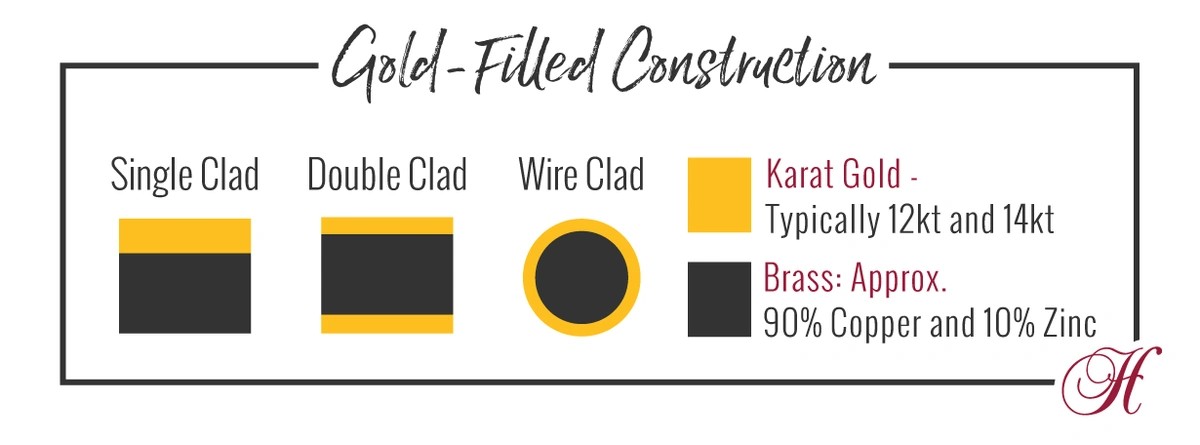Gold-filled jewelry is a popular choice for those seeking a durable and affordable alternative to solid gold. Understanding what gold-filled is, how it’s made, and its properties is essential for both designers and consumers. This guide will answer your burning questions about gold-filled, helping you make informed decisions.
What Exactly Is Gold Filled?
Gold-filled is a layered material composed of a base metal, typically brass, bonded with a layer of gold alloy. This is achieved through heat and pressure, creating a strong and lasting bond. Unlike gold plating, which involves a very thin layer of gold, gold-filled contains a substantial amount of gold, making it more durable and tarnish-resistant.
Gold-filled is legally required to contain 5% or 1/20 gold by weight. This gold content is expressed by the karatage of the gold alloy used on the surface. Commonly, 12kt or 14kt gold is used, and the material is labeled as 14/20 or 12/20 Gold-Filled. This notation indicates the karatage of the gold and that it constitutes 1/20 of the total weight. The abbreviations 14/20 GF or 12/20 GF are also acceptable stamps.
Interestingly, some Italian gold-filled incorporates a small amount of cobalt into the brass core. Cobalt enhances the material’s hardness and durability, but also makes it slightly magnetic.
Common Questions About Gold Filled
Let’s dive into some frequently asked questions to clarify the properties and uses of gold-filled material:
1. Why aren’t more cast products available in gold-filled?
Gold-filled’s layered construction prevents casting. Casting involves melting metal, which would alloy the gold layer with the base metal, destroying the distinct layers. Gold-filled items are crafted from sheet, tube, or wire to preserve their layered structure.
2. Why is there no gold-filled solder?
A true “gold-filled solder” doesn’t exist. When soldering gold-filled, use a 14kt gold color-match plumb solder to best match the surface color. Soldering gold-filled requires specialized equipment and training, such as laser welders for precise joins. Traditional soldering methods with a torch can alloy the gold surface with the brass core, resulting in a dark solder stain. If the brass is exposed, it will tarnish and blacken. Repairing such damage often requires plating the entire item. Avoid sanding or filing gold-filled to maintain the integrity of the gold layer.
3. Can I refer to gold-filled items as “gold”?
No, it is misleading and potentially illegal to call gold-filled items simply “gold”. Gold-filled must be clearly differentiated from solid gold. Accurately describe the material as either 12k gold-filled or 14k gold-filled in all product descriptions to comply with Federal Trade Commission (FTC) regulations.
4. Is gold-filled the same as gold plated?
No, gold-filled and gold-plated are distinctly different. Gold plating involves a very thin layer of gold applied to a base metal, typically comprising 0.05% or less of the product’s weight. Gold plating wears off easily, exposing the base metal. In contrast, gold-filled contains 5% gold alloy by weight, with all the gold on the surface, providing greater protection against tarnish and wear.
Gold-filled is made by sandwiching the core metal between two layers of gold alloy and then bonding these layers using heat and pressure. Gold-plated items are created through electroplating, where an electric current deposits a thin layer of gold ions onto the base metal. Gold-filled items are sometimes finished with gold plating to protect solder seams and provide a uniform color. To determine if a Halstead product is gold-filled and plated, check the ‘Specs’ section on the product detail page for a ‘Gold-Plated’ finish.
5. Can gold-filled tarnish?
Yes, gold-filled can tarnish, but it’s less common than with gold-plated items. The thick gold layer makes gold-filled pieces durable and long-lasting under normal wear. However, exposure to extreme sulfide environments can cause blackening. Examples include:
- Transit through polluted shipping docks
- Storage in nail salons with high levels of chemical fumes
- Exposure to smoke from fires
- Use in permanent jewelry (not recommended)
Regular cleaning with a soft cloth or mild soapy water is usually sufficient for gold-filled jewelry.
6. Can you be allergic to gold-filled?
Individuals sensitive to gold alloys may react to the gold alloy layer in gold-filled jewelry. Skin reactions can include blackening or rashes. This is due to the body’s chemistry reacting with certain metals.
7. Why does color variance exist between gold-filled items?
Color variations in gold-filled items stem from different finishing processes used by manufacturers. While many items adhere to the “Hamilton” color standard, variations in yellowness, tawny tones, or darkness can occur. This variance has increased as more manufacturers enter the market and consumer preferences evolve. Some manufacturers apply a plating layer to achieve a specific color finish.
8. Is gold-filled waterproof?
The term “waterproof” is a regulated product claim requiring specific coatings, treatments, and laboratory testing. Avoid marketing gold-filled as “waterproof.” While occasional exposure to swimming pools, seawater, and showers is generally safe, prolonged exposure to chemicals and minerals in dishwater, spas, or hot springs should be avoided.
In Conclusion
Gold-filled is a valuable and reasonably priced alternative to solid gold, especially suitable for jewelry design. Most gold-filled products are made in the USA or Italy, ensuring high-quality standards. By understanding the properties and care requirements of gold-filled, both designers and consumers can appreciate its beauty and durability.

